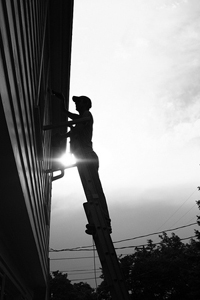Exterior Painting Tips
Exterior House Painting


Exterior Surface Preparation
The absolute most important part of a quality exterior paint job is surface preparation. You can spend top dollar on the best paint on the market but it won’t matter a bit if you’ve skipped proper surface preparation.
In order for paint to properly adhere to the surface (wood, brick, stucco, Masonite, cement board, metal, etc), it must be properly cleaned of all dirt, grease, oil, loose paint and other materials. One of the best ways to start the surface preparation is using a good quality pressure washer.
Once you’ve pressure washed the house you’ll need to scrape any remaining loose paint from the house and make any necessary repairs in cracked, rotted or loose siding and trim. It may be necessary to use a combination of scraping, sanding, and even chemical strippers to remove paint that’s in bad shape or not properly adhered to the siding.
It’s very important that you consider safe lead paint practices if you’re home was built prior to 1978. The new Lead Paint Law that went into affect can give some guidance on safety precautions.
Once all the surface has been cleaned make sure it dries well. Some professional painters will use a wood moisture meter to check the siding before applying the paint.
Be sure to seal all trim and siding gaps with a good quality latex caulking. Be sure the caulking says that it’s paintable on the package.
Primer
Depending on the condition of the existing paint it may be necessary to add a coat of primer before the finish coat of paint. Primer is essential if there are any areas of bare wood. When you ask most professional painters they almost always recommend an oil based primer.
Quality Top Coat Paint
Once all the hard surface preparation is finished you’ll need to apply a coat or two of good quality exterior paint. The paint is certainly not a place to skimp on to save a few bucks. After all, if you’ve spent the time to properly prepare the surface for paint the last thing you want to do is apply an inferior product.
Over the years I’ve come to respect good quality paint. But I’ve also realized that many people have personal preferences for certain brands and that’s ok. Myself I’ve had excellent luck with two exterior paints: Sherwin Williams and Behr. The last complete house that I painted was a cedar shake house that we used Behr Premium on and it came out wonderful. That paint job is over 5 years old and still looks great!
A friend of ours recently wrote an article about painting a garage door and he also used Behr. This year when I was at the 2010 IBS I went to a demonstration for Behr paints and was very impressed with their latest formulations.
Final Painting Advice
Painting really isn’t rocket science. However, if you want to save big money on an exterior paint job then you’ve got to be willing to take your time and do the job right. Painting a large house might take $1,000 to $1,500 in materials. A professional painter might charge $5,000 to $15,000 for a job that size depending on the complexity and condition of the existing paint. So the possible savings is huge but the end result will only be the same if you spend the time. Preparation….preparation….preparation. Don’t skip the preparation!
Photo Credit: Miss Kitty
Recent Posts
Framing Stick Nailer vs Coil Nailer
Which is Better a Stick Nailer or Coil Nailer? Framers have many choices in nailers…
How Many Roofing Nails Per Square of Shingles
Estimating How Many Nails for a New Roof When it comes to estimating materials for…
Composite / PVC Decking – Layout Tips & Advice
Composite / PVC Decking Layout Tips and Advice Composite and PVC decking have really changed…
Benefits of an ERV System (Energy Recovery Ventilator)
Benefits of ERV Systems (Energy Recovery Ventilator) If you're building a new home or doing…
Vermiculite Attic Insulation Abatement
Vermiculite Attic Insulation If your home was built before 1990 there is a chance it…
Nuisance Tripping of AFCI (Arc Fault) Circuit Breakers
Arc Fault (AFCI) Circuit Breakers Tripping Often An arc-fault circuit interrupter (AFCI) or arc-fault detection…